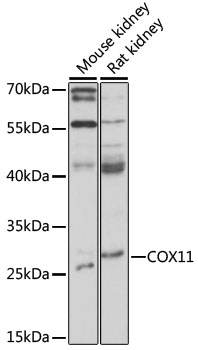COX11 Polyclonal Antibody
For reference only. Please follow the manual included in your kit for instructions.
Catalog Number
RD88534A
Product Name
COX11 Polyclonal Antibody
Catalog Number
RD88534A
Clonality
Polyclonal
Purification Method
Affinity purification
Isotype
IgG
Host
Rabbit
Background
Cytochrome c oxidase (COX), the terminal component of the mitochondrial respiratory chain, catalyzes the electron transfer from reduced cytochrome c to oxygen. This component is a heteromeric complex consisting of 3 catalytic subunits encoded by mitochondrial genes and multiple structural subunits encoded by nuclear genes. The mitochondrially-encoded subunits function in electron transfer, and the nuclear-encoded subunits may function in the regulation and assembly of the complex. This nuclear gene encodes a protein which is not a structural subunit, but may be a heme A biosynthetic enzyme involved in COX formation, according to the yeast mutant studies. However, the studies in Rhodobacter sphaeroides suggest that this gene is not required for heme A biosynthesis, but required for stable formation of the Cu(B) and magnesium centers of COX. This human protein is predicted to contain a transmembrane domain localized in the mitochondrial inner membrane. Multiple transcript variants encoding different isoforms have been found for this gene. A related pseudogene has been found on chromosome 6.
Immunogen Information
Immunogen
Recombinant fusion protein of human COX11
Gene ID
1353
Swissprot
Q9Y6N1
Synonyms
COX11COX11P
Calculated MW
39kDa/50kDa
Observed MW
51kDa
Applications
Reactivity
Mouse,Rat
Tested Applications
WB
Conjugation
Unconjugated
Dilution
WB 1:500-1:2000
Concentration
1mg/mL
Storage Buffer
PBS with 0.01% thiomersal,50% glycerol,pH7.3.
Storage Instructions
Store at -20°C Valid for 12 months. Avoid freeze / thaw cycles.
